Diary of an Escaped Expatriate - FOODIE EDITION (part 2)
I wrote so much about Indonesian food that I had to split it in 2 in order to be able to post it! Go back and read part 1, if you haven't yet!
Kwetiau (kway-tio, kwetio and other variant spellings) goreng: Ribbon noodles made from rice fried with cabbage, greens and some other veggies, fried egg, sweet soy sauce and some spices, and shredded chicken, meatballs and/or other types of meat, including seafood variants. Not a good choice for take-home if you find a superior vendor as the special flavor when it is fresh quickly disappears, presumably because it is soaked up by the noodles, so eat immediately upon being served! You can also get kwetiau kuah (soup) or siram (sauce) and other variants instead of being fried. The dried yellow noodles are the least enjoyable, followed by the dried white noodles, and the absolute best are the fresh white noodles. It's usually for lunch and dinner.
Kwetiau goreng with fried garlic on top:
Kripik: basically, chips, usually made from cassava (common) or potatoes, but also from other things, such as bananas.
Krupuk: a staple addition to meals, this is basically puffed crackers (think Funyons and cheese puffs like Cheetos) made by frying a batter in oil. The batter is often made with wheat or cassava flour, salt and may include meal from fish (ikan, amplang, kemplang), shrimp (udang), garlic (bawang putih), onions (bawang bombai), shallots (bawang merah), skin (kulit) and/or other ingredients. They are often sold in their "raw" form in stores and look like small, hard, colorful chips which expand in hot oil to become large, crisp and crunchy. They are served with a wide variety of dishes, eaten as a snack, used to absorb left-over broth/soup and even dipped in tea. In a pinch, they are so absorbent (even if they are old and soft from air humidity) as to be a quick stand-in for noodles in your soup. Krupuk quickly absorbs humidity, become soft and difficult to chew, so it's best to keep it stored in an air-tight container.
Krupuk in the traditional containers they are stored in, which stay both cool and dry.

Uncooked krupuk chips in the foreground:

Shrimp krupuk usually has an orangish color:
Fish krupuk is usually white to light yellow:
Krupuk amplang:
Krupuk kemplang:
Krupuk mi kuning:
Pork rinds are rare as Muslims and Jews cannot eat pig, so other animals are used - usually cows. Krupuk kulit has a light brown color and a strong flavor:
Lalapan/lalap/lalab: Raw vegetables served as part of meal, or a side dish, often with sambal. Most common are green eggplant (terong/terung Belanda), cabbage (kol), cucumber (ketimun), tomatoes (tomat), fresh basil sprigs (kemangi), and leunca (Solanum nigrum (black nightshade) edible variant's green berries). Sometimes, other foods, such as steamed mini-chayote squash, which has a flavor that is similar to corn, and papaya leaves.
Leunca:

Lalapan, including some steamed veggies:

Green eggplant/Tamarillo:
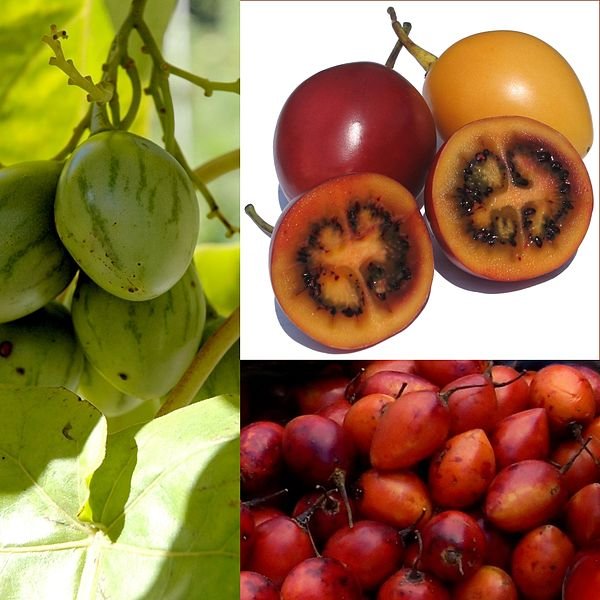
Martabak telor: Originally from Saudi Arabia, this is an oil-fried meal made with a pastry shell that is actually laid directly into the oil and then filled with a mix of eggs, leeks and spices, and then the shell is folded to cover the filling. A special, very large, shallow, edgeless pan with oil in it is used, and oil is constantly pushed onto the top of the martabak with a long metal spatula. It is flipped once during the process, then cut up and served. Martabak Mesir is the same, but it is served with a sauce that is very similar to that used with pempek, and you can pour it over or dip it into it. Quite yummy and a crowd pleaser, it's most often served from afternoon until night.

Mie Ayam: This chicken noodle soup is mostly noodles, with greens, celery, leeks, sweet soy sauce, and a modest amount of chicken broth and ayam swir (shredded chicken). The noodles are also called bakmi, which is from Hokkien. It is extremely popular for lunch and dinner. Mie kuah has more broth. The noodles are long and cylindrical, and made with wheat flour. The picture shows it with jamur merang, which is an encapsulated mushroom that has to be cooked soon after picking as it quickly takes on a bitter flavor. Most mie ayam doesn't have mushrooms.
Mie ayam with straw mushrooms:
Minyak wijen: Sesame oil. Hint: the cheap brands are inexpensive for a reason! Get the expensive stuff if you want good flavor!
Nasi: There are many names for rice because it is the main staple of most of the country, but most of the names (such as "padi") don't refer to the edible rice but rather to the pre-cooking stages, including the chaff (sekam). There aren't as many varieties as in the US, with white variants, including Jasmine, being almost the only thing available, although white glutinous (sticky) rice (which has a bright white color compared to regular rice) is used for a variety of snacks and desserts, and certain meals. Red rice is a distant third in terms of ability to find, with black rice being a distant fourth from red. You'll almost never see yellow and brown variants. Organic black rice is fragrant and loaded with vitamins and minerals, and has a fairly low glycemic index, making it the most healthful choice. When combined with red rice, it provides a lot of fiber, too. Although red rice was once the rice of royalty, it is now most often used for livestock, although it and black rice have enjoyed a recent resurgence in popularity as Indonesians start to look for healthier choices due to the increase in obesity, hypertension, diabetes, stroke, gout and heart attacks due to excessive consumption of meat, fried foods and sweet foods.
White rice:

Red rice:

Black rice is really purple!
Sticky rice - warning: too much can cause heartburn...
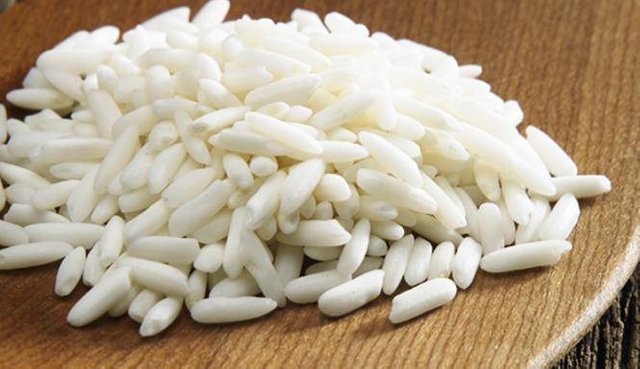
Nasi goreng: Fried rice is something Indonesia is famous for. It's not like the Chinese vegetable fried rice in the US - it's got verve, it's got flavor, it's got variety! There are numerous kinds of fried rice, but the traditional one is tasty and piquant. It's not my preference (although my wife knew what I liked), partially because the oil upsets my tummy, but a lot of people love it from around the world! It's eaten for all meals! The picture shows fried rice with "pete" (stinky beans). Most fried rice is served with cucumbers and a sprig of basil, although many varieties exist that include veggies and meat.
Fried rice with stinky beans:
Fried rice with seafood, eggs, sausage and acar (side):
Fried rice with sliced cabbage, shredded chicken, shrimp krupuk, fried egg and tomato.

Opor Ayam is the coconut-milk based chicken soup I mentioned above. It sometimes includes "labu siam" (chayote) julienned. It has a delicious flavor! It's usually for lunch and dinner, and is a traditional meal for special holidays.
Padang internal organs: If you've never been brave enough to try brains, kidneys, liver, lungs, tripe, etc., the best way to have them is Padang-style cuisine. Their flavorful (and often piquant) recipes will please your palate. However, especially for men and women past menopause, you should eat internal organs sparingly as routine consumption is bad for your health and leads to hypertension, gout and other diseases. It's usually for lunch and dinner. The picture shows a wide variety of foods served at Padangian restaurants, although this one doesn't stack its plates.
A wide variety of Padangian foods, including organs:
Pandan aka Pandan Wangi (fragrant screwpine): Pandan amaryllifolius is a plant that produces long sharp leaves that have a couple of thorns on them, and were once used for fighting. They are used both to provide a bright or deep green color, and also for the fragrant and pleasant flavor contained in the leaves - for soups, desserts and main meals, as well as both a garnish and decorative element. It is an easy plant to grow but sensitive to transplantation.
Pecel, like gado-gado, is made of spicy peanut sauce and steamed vegetables, but it has a different variety of vegetables, including "kangkung" (water morning glory, because of its flowers and preference for growing in water) and slightly different sauce (usually piquant), so it's also a nice choice for vegetarians. It's usually for lunch and dinner.
Pempek/Empek2: This fried or steamed food is made from mackerel, tapioca, eggs and various other ingredients into a dough that can be shaped. There are many kinds of pempek, mostly based on shape and/or special ingredients. It is always served with a special sauce that includes vinegar, Javanese (molded) sugar and other ingredients, and is usually spicy. It usually is also served with yellow mie and/or so-un (glass noodles) It is steamed first and you can then eat it that way or have them fry it. You should always enquire as to whether they make it fishy or not, because some areas prefer that (and it can be fairly strong), while others prefer it to not have a fishy flavor. The strongest flavored one, in terms of fishiness, will be the "kulit" because it's made with the fish skin. It's usually for lunch and dinner.
Most of the more common varieties:
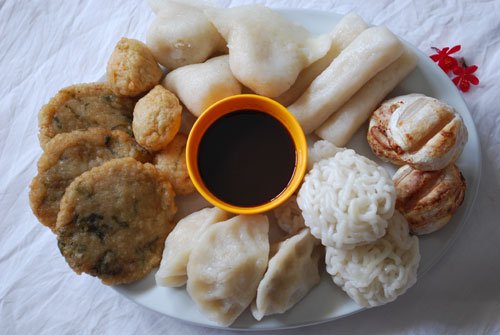
From left, Kapal selam, lenjer and adaan, with sauce:
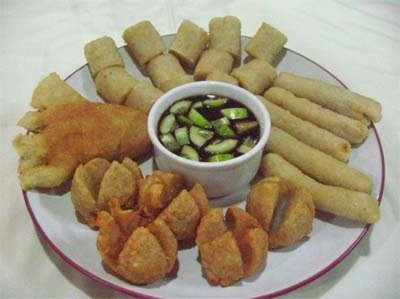
Pempek dough being shaped into pempek keriting (curly):
Standard flavor:
Lenjer: cylindrical, like a sausage; very common.

Pempek kapal salam & keriting with cucumbers and so'un (glass noodles), with the special sauce being poured in

Keriting is curly dough shaped into a ball. It was my wife's favorite. It's somewhat rare.
Variant flavors:
Pistel is similar in shape to kapal selam, but it contains julienned young papaya. It is very tasty but very rare.

Adaan is ball-shaped and has an onion flavor because chopped leeks or onions are mixed into it; very common. It's my favorite, along with pistel.

Tahu: Tofu sliced open and filled with pempek dough; very rare.

Model: Tofu enclosed in pempek dough; very rare.
Tunu: Grilled patties; very rare.
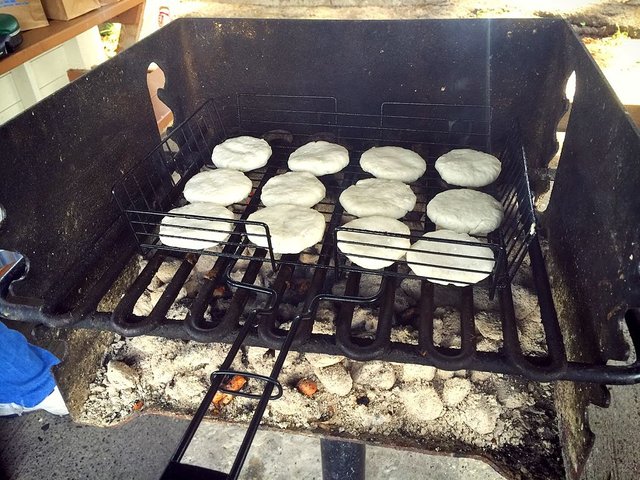
Lenggang: pempek diced and cooked in an omelette. Quite tasty.
Laksan: pempek served in laksa, a fishy coconut-milk soup; rare.

Tekwan: chopped pempek in soup with bengkuang (jicama), mushrooms and fishballs; rare on the street.

Celimpungan: small balls cooked in piquant coconut milk, served with chilis and sprinkled with fried onions (bawang goreng). I've never seen it.
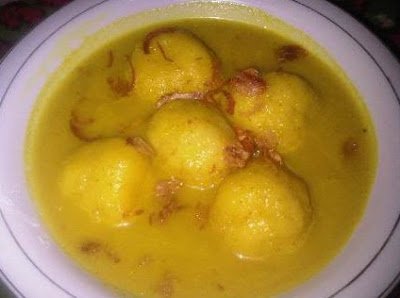
Kapal selam has all or part of an egg inside of it (it's shaped with the egg liquids, beaten or intact, before cooking), and is shaped like a half moon that's pinched shut; very common. Small ones, sometimes "telor kecil" (little egg) only have half a beaten egg, or a quail egg. The name means "submarine" because the egg is akin to a person.
Kulit is made from fish skin and has the strongest fish flavor, and is in a patty; it's color is darker than other types.
Pempek kapal salam and kulit with cucumbers in pempek sauce

Pepes: This is a steamed snack/meal that comes in wide variety, including fish, chicken and mushrooms. It is sometimes grilled after steaming. Pepes usually includes chilis and certain spices and veggies. Results vary wildly, but are usually strongly flavored.
Grilled pepes:

Goldfish pepes:

Grouper pepes:

Mushroom pepes:

Chicken pepes:

Perkedel: Mashed potatoes with leeks and spices, shaped into patties and then fried in egg batter. Very tasty! Some varieties include canned corned beef (cornet).
Pete (Parkia speciosa): Stinky beans are a green type of bean (legume) that grow in 10-12" long pods and has a strong flavor and taste - strong enough to make your urine stink! It grows on tall trees with small leaves and is expensive. While some people eat it plain, I recommend eating it in a dish, such as this, so that the flavor is muted. In Sambal, it is pretty good.
Poffertjes: A tiny pancake or ping-pong-sized ball made with wheat flour and cooked in an iron mold, it is often topped with powdered sugar or vla, a custardlike dessert sauce that often tastes of vanilla.


Rawon: A tasty, savory soup with chunks of beef, bean sprouts and the leaves of a specific tree, along with a variety of spices, and is always served with rice, so it's sometimes called Nasi Rawon.
Rendang: This dark Sumatran delicacy from the Minangkabau area is usually for lunch and dinner, and is also used for certain holidays. This dish, although also claimed by Malaysia, was recognized by the UN as being Indonesian. It is most often chunks of beef cooked in a savory, spicy, coconut milk sauce until the meat is soft and it becomes a stew. It often includes kidney beans and/or small potatoes. It is a very complicated recipe, as are many Indonesian recipes (rivaling even French cuisine in complexity), and may take 12 hours to cook. It must be slow-cooked (and cannot be rushed or taken off the stove before done) to allow the meat to cook without the sauce burning or the oil separating out of the coconut milk, and so that the spices soak into the ingredients properly. When oil from the coconut milk starts to form on top, it is done - even if it's undercooked - or it'll be ruined. Cheap varieties have tough meat in them and have an inferior flavor, and bastardized variants in Java are too sweet and lack the correct flavor. This is a must-try meal, eaten with rice. If you're a vegetarian, just try the sauce!
Rica2 Ayam Manado: This is probably the best variety of rica-rica, but is not the most common. It is composed of a piquant red sauce that is somewhat sweet and salty with lemon overtones (lemon/lime leaves are an ingredient, as is lemongrass). Rica-rica is also served with fish and beef as the base, although tofu or tempe can be substituted. This is another must-try if you can handle spicy food!
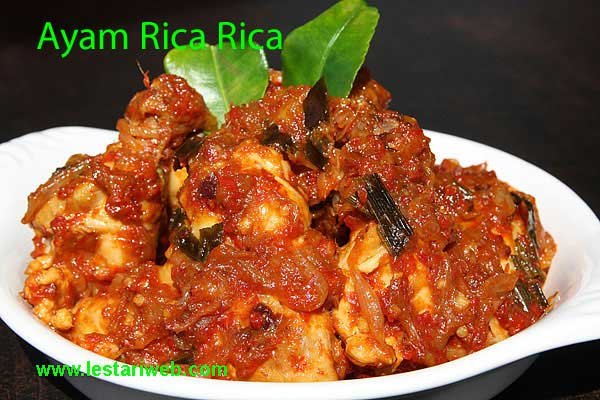
Rujak: Under-ripe fruit, sometimes grated (serut) or crushed (bebek/tumbuk) or in other varieties, served with a sweet, salty and sour, usually spicy, thick, brown sauce. It most often contains terasi. I can't stand it but many people love it, especially (it seems) women.
The sauce:

Rujak tumbuk:
Sambal: Chili pepper sauce from Indonesia doesn't taste like Tabasco or salsa (except for one variant from the island of Sumba in East Nusa Tenggara). There are numerous varieties: fried, with terasi, with ikan teri, with pete, dry, raw, cooked...There are probably in excess of 100 varieties from all over the archipelago! Look here for a short list.
Shrimp paste (terasi) sambal:
Sambalado: Boiled eggs fried in oily sambal.
Sate Bali: Also known as Sate Lilit, this Balinese treat is a delicious mixture of fish and spices pressed onto a bamboo skewer and grilled, and is probably the best sate in Indonesia. It's usually for lunch and dinner.

Sate Kambing: Some cuts of goat meat has a lot of cholesterol, but if you can find it, this stuff is very tasty. It's usually served with cut shallots and very piquant chili peppers called cabe rawit in kecap. It's usually for lunch and dinner.

Saus tiram: Oyster sauce, a thick, dark-brown sauce made with oysters (or substitute).
Semur: A rich stew, usually made with chicken or beef and tofu, potatoes, onions and tomatoes, with a variety of spices and kecap, and topped with fried shallots.
Serabi: A type of pancake served with grated coconut or other toppings. Serabi solo is colored green by pandan and is served with a palm sugar liquid.


Siomay: This is a type of dimsum, most often made from fish or shrimp, but sometimes chicken or mushrooms. There are several varieties. Siomay is cooked by steaming and may rarely be fried before sale. Some varieties, like those from Bandung, are like little cups and are served with a piquant sauce, while others may be served with a peanut sauce that ranges from peanut-butter flavored and thin to very thick and rich like gado2 sauce. Often, street vendors will offer it with potatoes, eggs, fried tofu, rolled cabbage leaves, bitter gourd (pare), and sometimes those were stuffed with the siomay dough, too. It's usually for lunch and dinner. Some varieties are fishy tasting, so smell before you buy.

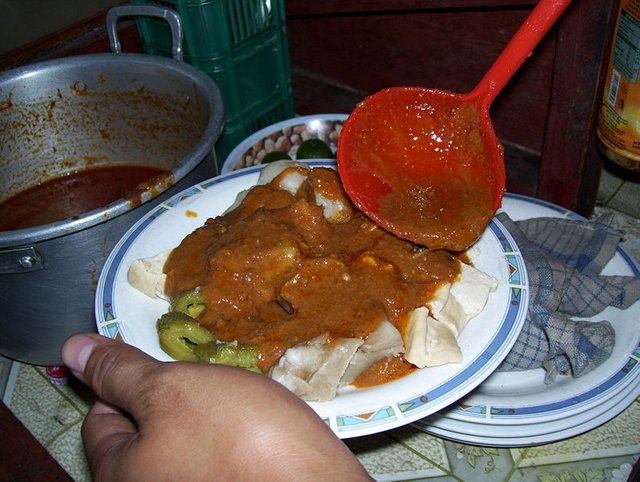
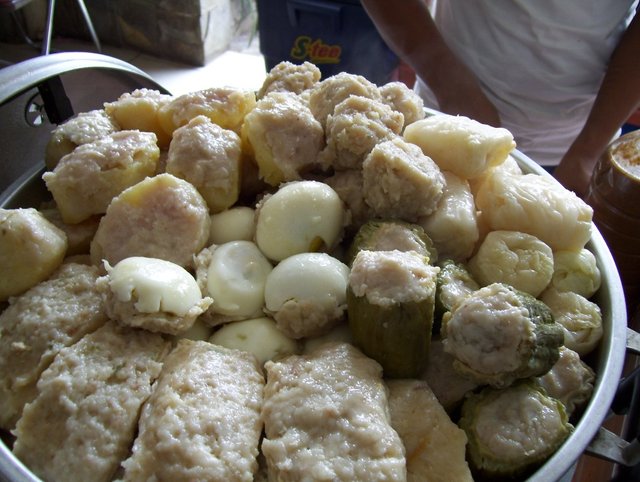
Siomay Bandung:
Soes aka Kue Sus: A classic Dutch dessert like a cream puff or eclair, but filled with firm vla or a cream filling.

Sop Ayam: Chicken soup (chunks or shredded meat) with a wide variety of vegetables and jelly mushroom. Some variants are bland while others are quite tasty. It's usually for lunch and dinner, but not nearly as popular as soto.

Soto Ayam: It's usually for lunch and dinner, and usually has a yellow color because of turmeric. There are numerous variants of this from all over the country, such as Sroto/Soto Sokaraja (which contains peanut sauce sambal), Soto Betawi, Tegal, Bandung, Lamongan, and Kudus. Some variants use beef or other types of meat, but most use chicken. Often contains bean sprouts, cabbage and tomatoes, topped with fried shallots.
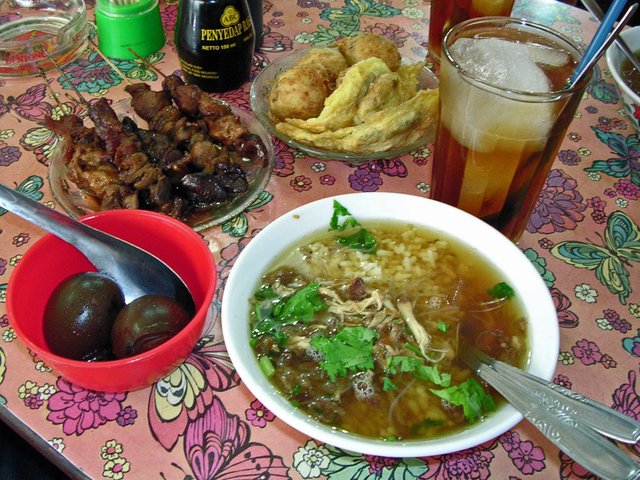

Tahu: Tofu, or soy bean curd, comes in many recipes, but we can narrow it down to basically two kinds: those with an acrid flavor I find unpleasant, and those with a cheesy flavor. Tofu's firmness ranges from almost liquid to extra firm, with the former usually being named "tahu Jepang" (Japanese), which is never acrid. Firm white tofu (tahu putih) is sometimes soaked in liquid pressed from turmeric, giving it a distinctly bright yellow color (tahu kuning). Brown tofu (tahu coklat) is fried, and is always made with the acrid tofu. It is difficult to explain to vendors which type you're looking for, so the best bet is to ask to open a bag and smell it. Tofu is used for any number of recipes, as a snack, in desserts, and as a meat substitute.
Soft tofu:

Firm tofu with piquant sweet soy sauce laden with chilis:
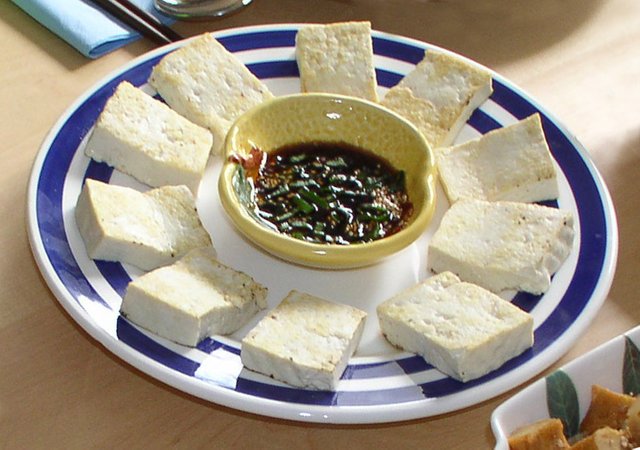
Fried tofu with rice:

Yellow tofu:
Tahu Campur: Tofu with raw tomatoes and steamed bean sprouts, with spicy kecap and rice, sometimes with other ingredients. Sweet and piquant, it's not for everyone, but I can't stop eating it!
Tempe: Tempeh, or fermented soy bean cake, is touted by some as being one of the few forms of soy that are safe for consumption. It is mostly commonly sold fried, batter-fried or as kering tempe, although you can sometimes find it in soups and even fried until dry and sold as a snack food. Perhaps the most famous tempe is mendoan, which is very thin slices fermented within individual banana leaf wrappers, that is then battered and fried with leeks, and served with spicy kecap.


Tempeh sauteed with green beans and tomatoes:

Tempeh burger:

Mendoan:
Tongseng kambing: This delicious soup is usually made with goat (kambing), but may sometimes use mutton or beef. It has a fragrant coconut-milk broth and often contains cabbage, bean sprouts and tomatoes, and is topped with fried shallots. It's usually for lunch and dinner.
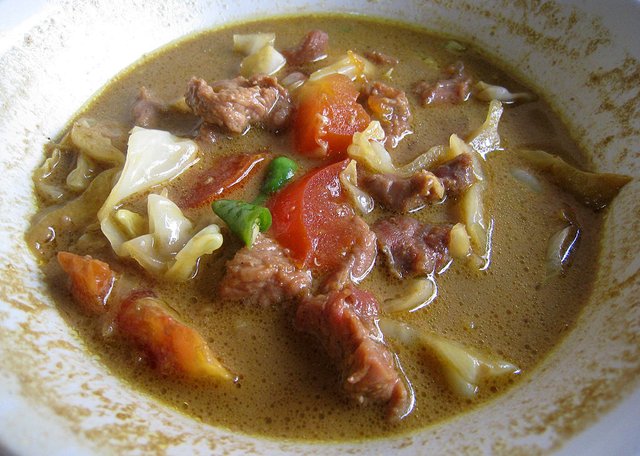
Tumpeng: This is actually a large cone of rice yellowed with tumeric (sometimes white), served with a variety of foods including ayam goreng, kering tempe, perkedel, abon sapi (finely shredded beef jerky), urap, teri kacang (teri fried with peanuts), empal gepuk (sweet & spicy fried beef), and others, especially lalapan, and is almost exclusively served for special events like weddings and birthdays.

Urap/Gudangan: Another steamed vegetable salad, this one is usually with string beans, bean curds, kangkung, young cassava leaves, papaya leaves, spinach, and shredded coconut spiced with Gula Jawa, salt and chilis. It is eaten with rice, as are most meals in Indonesia (although some areas use cassava root instead).
Vla: Vla (pronounced "fla") ranges from a pudding to custard consistency, and can be eaten by itself for dessert, or on top of another dessert, such as poffertjes and Indonesian poding (made with agar-agar, making it similar to gelatin, and with a variety of flavors) and as a filling for Sus. The most common flavors of vla are vanilla, rum, and chocolate, but there are others.
Vla on waffles:

Vla on poding:

Yamien: This is a variant of mie ayam that, when properly prepared, tastes of mushrooms (although mushrooms aren't used), and has less broth, but is basically identical to Mie Ayam in appearance (with less greens). It's hard to find it made properly, but I've had it in Jakarta and Yogyakarta.
Beverages
There is a wide range of beverages in Indonesia, from soft drinks, tea and coffee, to iced tea and variants thereof, plus a large number of traditional beverages. I'm going to have to cover this another day.
You may be wondering why I don't post a lot of pictures from my time there. Well, in my early years there, I had a hard drive crash that caused the loss of some of my photos, although I had many backed up to DVDs. Then, in 2015, my backup HDD was stolen, which contained the majority of my photos and, finally, I had to hastily leave Indonesia, resulting in the loss of all my printed photos as well as the old DVD backups from the early years. Thus, aside from what can be found online, I lost a huge number of photos. :(
Most images from Wikipedia and Pixabay.
If you appreciate this article, please upvote/like , resteem/share
, resteem/share and share it to Facebook
and share it to Facebook , Twitter
, Twitter , Reddit
, Reddit , LinkedIn
, LinkedIn and wherever else
and wherever else you can!
you can!

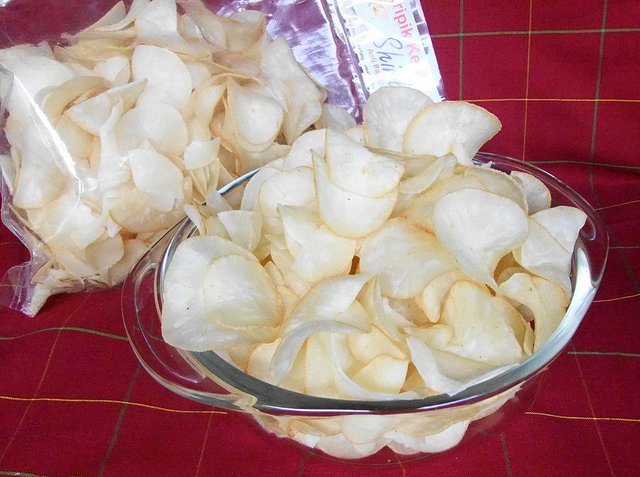

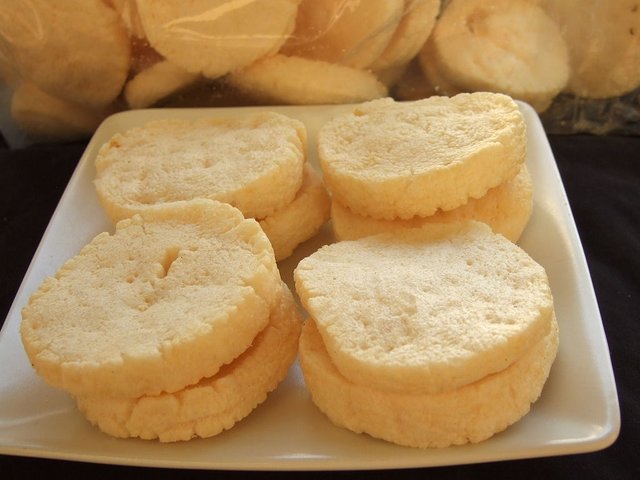



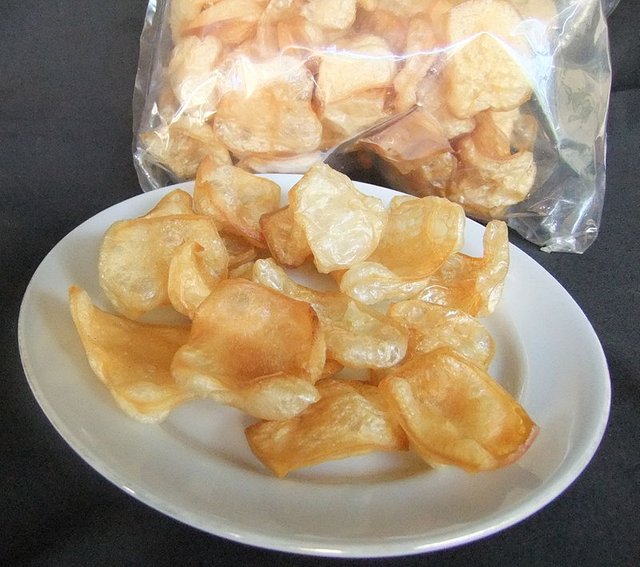

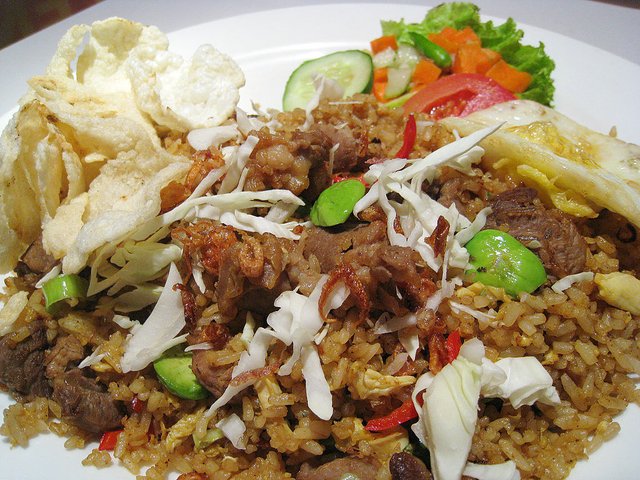



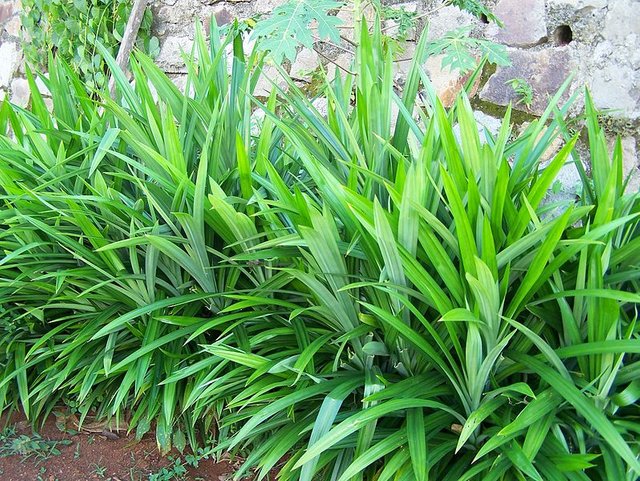

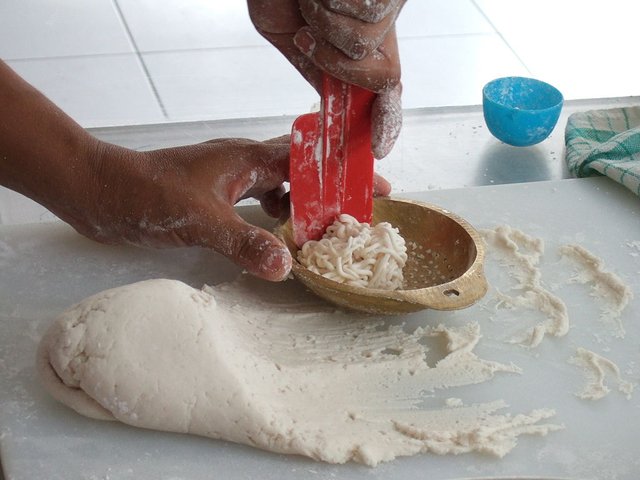










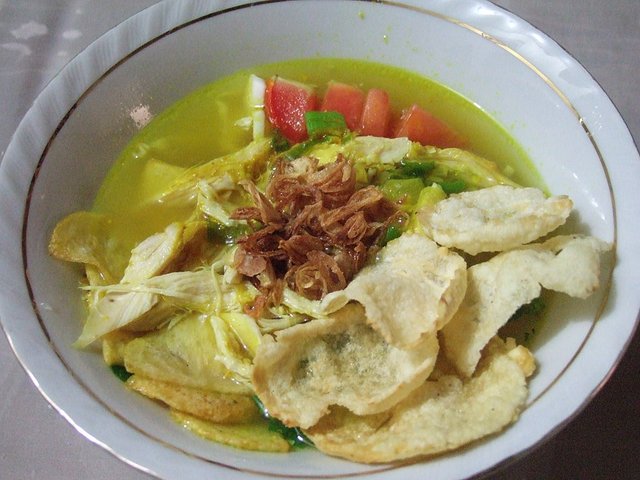

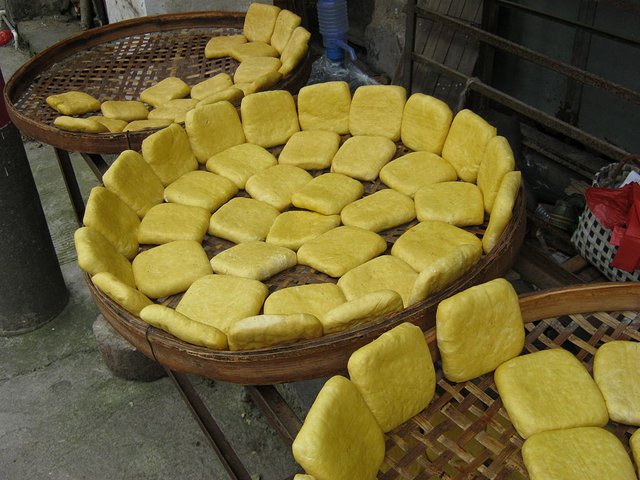

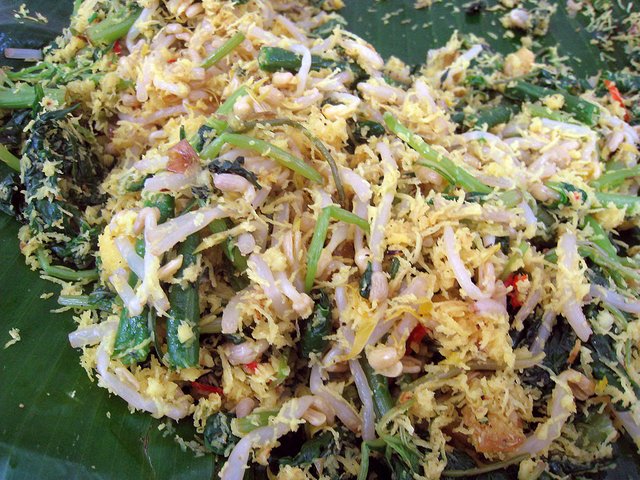
yammy foods .nice post
Are you from Indonesia?
That's only a tiny fraction of what I could've posted, and I haven't covered drinks, yet. I hope you saw the other part!